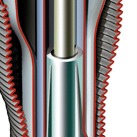
Air ride diagnostics is more than a spray bottle of soapy water. On today’s late-model vehicles, it requires a scan tool, meter and scope. Swapping components will only lead you down a diagnostic black hole that leads to an angry customer and parts supplier.
Ride Height Sensors
In the past decade, the ride height sensor has changed dramatically. In the past, it was nothing more than a switch that engaged a relay to turn on the compressor so the vehicle would rise to the correct height.
The next step in the evolution was a potentiometer that would change the voltage to tell the air ride control module the position of the suspension.
The most sophisticated systems use a Hall effect sensor. This sensor can be used to show the position of the suspension with more precision. The sensors typically use two sensors in one unit for redundancy. The wave pattern will overlap much like a steering position sensor.
Valves and Compressors
Modern air ride systems have a compressor and a module to control the flow of air to the struts or shocks. Control modules can have as many as 10 valves. They can also have three or more sensors to measure the pressure.
Purge and other valves can have sensors that measure the position. These sensor measure the position of the valves to detect problems that could cause an over or under inflation condition.
Diagnostics
For any type Hall or resistance-type of ride height sensor to work, it requires the correct voltage and a good ground. If the ground is shorted or open it will produce a faulty reading or no information at all.
Testing these sensors can be done with a meter, scope or scan tool. With a meter, it is possible to observe changes in the voltage or resistance on both resistance and Hall effect sensors. It can also be used to measure voltage drop and the health of the grounds.
Using a scope can yield more accurate information. A scope can be used to graph the voltage, resistance and even the wave pattern of a sensor as it is actuated.
Scan tools are essential for working on some systems. Some enhanced scan tools can observe PIDs for the air ride system like valve operation, modes and vehicle position. Some new vehicles, like GM, have a calibration process for the ride control system.
Information
Another key diagnostic tool is service information. Information on how the system behaves is critical in testing and diagnosing the system.
Information like pin-out valves, thermal protection and serial data bus communications can help you diagnosis the system right the first time.
Some customers may complain of intermittent stiff ride or bottoming out after they get off the freeway. Or, they could complain that the vehicle does not handle well at high speeds. Without the service information, you could be behind the wheel a long time trying to repeat the customer’s complaint.
With service information, you would realize that the system could have a highway mode that lowers the suspension for handling and fuel efficiency. Some air ride systems even drop the nose.
The Reality
With the complexity of some air ride systems, repair of the system may not be economically viable. Some companies are offering conversion kits which switch the vehicle to a conventional system with hydraulic units and springs.
 Air ride diagnostics is more than a spray bottle of soapy water. On today’s late-model vehicles, it requires a scan tool, meter and scope. Swapping components will only lead you down a diagnostic black hole that leads to an angry customer and parts supplier.
Air ride diagnostics is more than a spray bottle of soapy water. On today’s late-model vehicles, it requires a scan tool, meter and scope. Swapping components will only lead you down a diagnostic black hole that leads to an angry customer and parts supplier. 













